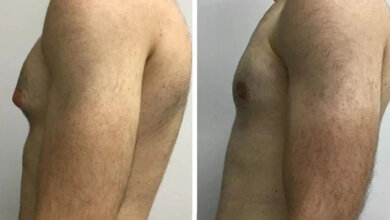
Gynecomastia is a condition in which men develop excess breast tissue, leading to a chest appearance that may resemble female breasts. It is often caused by hormonal imbalances, weight gain, genetics, or certain medications. While not dangerous to health, it can have a strong emotional and psychological impact on self-esteem.
Why Surgery Is the Preferred Solution
Although exercise and weight loss can help in some cases, they cannot remove glandular tissue responsible for gynecomastia. This is why surgical options are often considered the most effective and permanent solution. For men considering Gynecomastia Surgery in Riyadh (جراحة التثدي في الرياض), understanding the available surgical techniques is crucial to making an informed decision.
The Four Main Options for Gynecomastia Surgery
Liposuction Technique
How It Works
Liposuction involves the removal of excess fat from the chest using a suction-based device. Small incisions are made, and a thin tube (cannula) is inserted to break down and remove fatty tissue.
Best For
-
Patients with fatty chest enlargement but minimal glandular tissue
-
Men with good skin elasticity that can naturally reshape after surgery
Benefits
-
Minimally invasive with smaller incisions
-
Shorter recovery time compared to other methods
-
Minimal scarring due to discreet incision placement
Excision Technique
How It Works
The excision method removes glandular breast tissue directly. This option is essential for men whose gynecomastia is caused primarily by gland enlargement rather than fat accumulation.
Best For
-
Patients with firm, glandular breast tissue
-
Men experiencing nipple enlargement or sagging that cannot be corrected by liposuction alone
Benefits
-
Precise removal of glandular tissue
-
Can reshape the nipple and areola if necessary
-
Provides permanent results when combined with lifestyle adjustments
Combination of Liposuction and Excision
How It Works
Many men benefit from a hybrid approach where both liposuction and excision are used. This technique addresses both fatty deposits and glandular tissue simultaneously.
Best For
-
Patients with both fat and gland-related gynecomastia
-
Individuals seeking a comprehensive and balanced chest contour
Benefits
-
Delivers the most natural-looking results
-
Effective for moderate to severe gynecomastia cases
-
Provides better chest symmetry and contour definition
Skin Removal Surgery
How It Works
In severe cases, where excess skin causes sagging along with fat and gland issues, skin removal surgery is performed. This often includes excision and repositioning of the nipple to achieve a masculine chest appearance.
Best For
-
Patients with significant weight loss leading to sagging skin
-
Severe gynecomastia cases with stretched skin and drooping
Benefits
-
Restores a flat, firm chest appearance
-
Improves body proportions after major weight loss
-
Offers long-term, confidence-boosting results
Recovery After Each Surgical Option
Liposuction Recovery
-
Typically 1–2 weeks of downtime
-
Light activity after a few days
-
Compression garments recommended
Excision Recovery
-
May require 2–3 weeks before resuming normal activities
-
Slightly longer healing time due to larger incisions
-
Scars fade over time with proper care
Combination Recovery
-
Averages between 2–3 weeks
-
Requires strict adherence to post-surgery instructions
-
Long-term results visible after swelling subsides
Skin Removal Recovery
-
Healing may take several weeks to months
-
More intensive aftercare required
-
Results are permanent but demand patience for final contour
Tips for Better Results Regardless of Technique
Follow Medical Instructions
Adhering to post-surgery care guidelines ensures smooth healing and reduces complications.
Maintain a Healthy Lifestyle
Balanced nutrition and regular exercise (once fully recovered) help preserve results.
Avoid Smoking and Alcohol
Both slow down healing and may negatively affect results.
Wear Compression Garments
Essential for reducing swelling and supporting new chest contours.
Be Patient With Results
Final outcomes can take several months to fully appear as swelling reduces and scars fade.
Emotional and Psychological Benefits of Surgery
Confidence Boost
Many men feel more confident in social settings and daily life after surgery.
Improved Posture and Fitness Motivation
With a flatter chest, patients often feel more comfortable engaging in fitness activities.
Clothing Options
Surgery allows men to wear fitted clothing without discomfort or self-consciousness.
Choosing the Right Option for You
Deciding which surgical method is best depends on individual needs, severity of gynecomastia, and body type. Consultation with an expert is crucial to tailoring the procedure to achieve the most natural and lasting results. Many men considering Gynecomastia Surgery in Riyadh find reassurance in knowing there are multiple safe and effective techniques available.
Final Thoughts:
Gynecomastia surgery is not a one-size-fits-all solution. With four distinct options—liposuction, excision, combination, and skin removal—patients can find a treatment that matches their condition and goals. By following recovery guidelines, maintaining a healthy lifestyle, and having realistic expectations, long-lasting and life-changing results can be achieved. For men seeking Gynecomastia Surgery in Riyadh, these options provide the clarity needed to make the right choice.
If you’re ready to transform your confidence and body, book your consultation today at Royal Clinic Saudia for safe, professional, and personalized care.
FAQs:
Which type of gynecomastia surgery is best for me?
It depends on whether your condition is caused by fat, glandular tissue, or excess skin. A consultation helps determine the right method.
Will I need general anesthesia for gynecomastia surgery?
Most procedures are performed under anesthesia for comfort and safety, but specifics depend on the technique used.
How long do results last after surgery?
Results are typically permanent, provided you maintain a stable weight and healthy lifestyle.
Can exercise alone treat gynecomastia?
Exercise can reduce fat but cannot remove glandular tissue, which often requires surgery.





